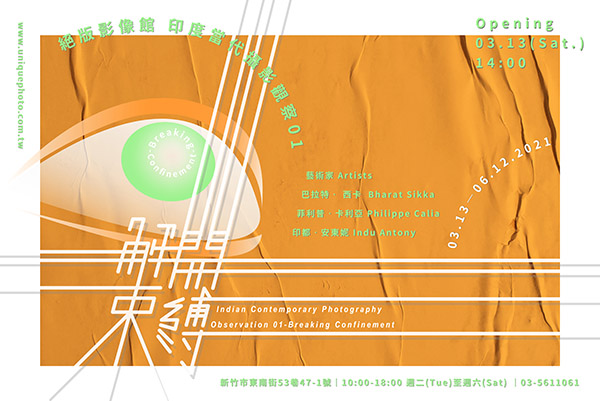EXHIBITIONS
Exhibitions ─ Previous
Indian Contemporary Photography Observation 01: Breaking Confinement
Indian Contemporary Photography Observation 01: Breaking Confinement
Duration: 2021/03/13-06/12
Opening reception: 03/13 (SAT) 14:00
Artists: Bharat Sikka, Philippe Calia, and Indu Antony
Venue: UP Gallery
UP Gallery is proud to present Indian Contemporary Photography Observation 01: Breaking Confinement a group exhibition from artists Bharat Sikka, Philippe Calia, and Indu Antony. The gallery is excited to announce that this is the inaugural Indian Contemporary Photography Observation series within the gallery program, where we introduce either new talent or important artists from the region to our audiences.
The exhibition begins with Bharat Sikka’s Matter series, muted tones almost too sleek enlaced with silver and monochromatic colors of white and grey connect the series of images. The stereotypical imagery of India with its vibrant hues, busy streets, and abundance of culture through forms of exotic gaze is broken and perhaps simultaneously revived by the artist. Sikka mixes high and low art, familiarity and alienation, energy and despair, transforming these imageries through a decade-long macabre allure. Observers wonder if these images are the perfect representation of contemporary India or a curated impulsion of emotions by the artist, for it is both natural yet artificial and undermines any form of confinement.
Space or void is another element of confinement, for without a form of restriction and boundaries ideals and the physical body can roam hence they are free. Institutions in a more literal sense are a form of a space where humans inhabit and so often do, they help constitute a society or a culture. In Philippe Calia’s Ajeeb Ghar Archive he wishes to explore a diverse and extensive range of museums in the region, focusing also on less accessible aspects to the public. Whether museums in big metropolises (like Delhi, Bombay, or Bangalore) or smaller towns, the series explores the museum-goer’s interaction process within these spaces. To further extend his search his works are presented as object-like forms, such as rotating frames or a book, these pieces in the gallery space also prompt interaction with viewers. We wonder are viewers confined to the knowledge of the exhibited, the space they in their habitat, or freed by the ability to develop judgments within their minds.
Lastly, we dig deeper into the concept of restraint through artist Indu Antony’s newest publication Why can’t bras have buttons? This handmade photobook is her ഓർമ പെട്ടി (Orma Petti translates as ‘memory box’ in Malayalam), it offers a tiny window into the artist’s memories and life through personal objects paired with short written text. Without an actual spine, leaves of memories take form as individual renderings and transform into an object that can be held by the hand. This photobook was created under the global pandemic in 2020 and further contextualized the cravings for physicality. Confined in an alone space and those endless zoom meetings, Antony searched inwards to her past and actively began stitching these trinkets with her hair. This act of stitching a partial part of the body to these personal objects meant revisiting memories and encountering mixed emotions, some pleasurable others painful. To confront is the first step to breaking confinement and for artists to actively create was solace in these troubled times.
What is confinement? The lack of physical mobility within environments, the deprivation of freedom to comprise independent thoughts or the struggle to find a balance between the social norms we occupy and the mind that defines us as a person? Or more importantly, how do we break them?
About the Artists
Bharat Sikka (b.1973 New Delhi, India)
born and raised in India, where he began his photographic practice before studying at the parson’s school of design, NY. Sikka’s long-term photographic projects have centered on the cultural residues and societal transformations within India, rendered with the visual language and material forms of contemporary art photography. His work subtly speaks to India’s history and regionality (of Kashmir, where the flowers still grow), the tide of globalization (matter), and masculinity (Indian men). Sikka has participated in many exhibitions including The Sapper (solo), Unseen Amsterdam, 2019; Reimagine (solo), Photoworks festival & Brighton festival, 2016; Where Three Dreams Cross: 150 Years Of Photography From India – Pakistan And Bangladesh (group), Whitechapel Gallery (London) & Fotomuseum Winterthur(Switzerland),2010; Space In-between, Les Rencontres d’Arles, France,2007; Paris Photo and Anne De Villepoix (Paris), 2006.
Philippe Calia (b.1985 Paris, France)
an artist, photographer, and filmmaker who has been living and working in India since 2011. His works are set within an eclectic documentary practice that privileges long-term involvement and mixes photography, video, and text. Interweaving themes of memory, time, and history, his processes focus on vernacular forms of expression, between “objets trouvés” and residual documents. The act of representing eventually becomes a reflexive one: approached through negation, it focuses on spaces in which the Image is either threatened with a disappearance or prohibited altogether. Since 2013, Calia has been collaborating with PIX as a photo editor and researcher. Between 2015 and 2020, he co-directed BIND, a platform for photography in India with a public photobook library.
Indu Antony (b. 1982 Kerala, India)
Indu Antony is an artist based out of Bangalore and Kerala, India. Born and raised in a conventional Indian family she overcame various social obligations to pursue her forms of expression. She has hence been working with individuals from the fringes of society. She is known to explore tonalities of inward discussions which later on bursts out into the communal spaces. Her work primarily revolves around the notion of spaces and their intangible character in relation to the gendered body as a site of representation by understanding feministic stands which give way to performances and installations. Indu Antony has participated in several group exhibitions including the Serendipity Arts Festival, 2018; Kochi-Muziris Biennale (Collateral), 2018-19; Foto Fest Biennale, Houston, 2018; Queer Asia Photo Exhibition, London, 2017 and Photo Kathmandu, Nepal, 2015. She won the Toto funds Award for photography for the year 2011.



